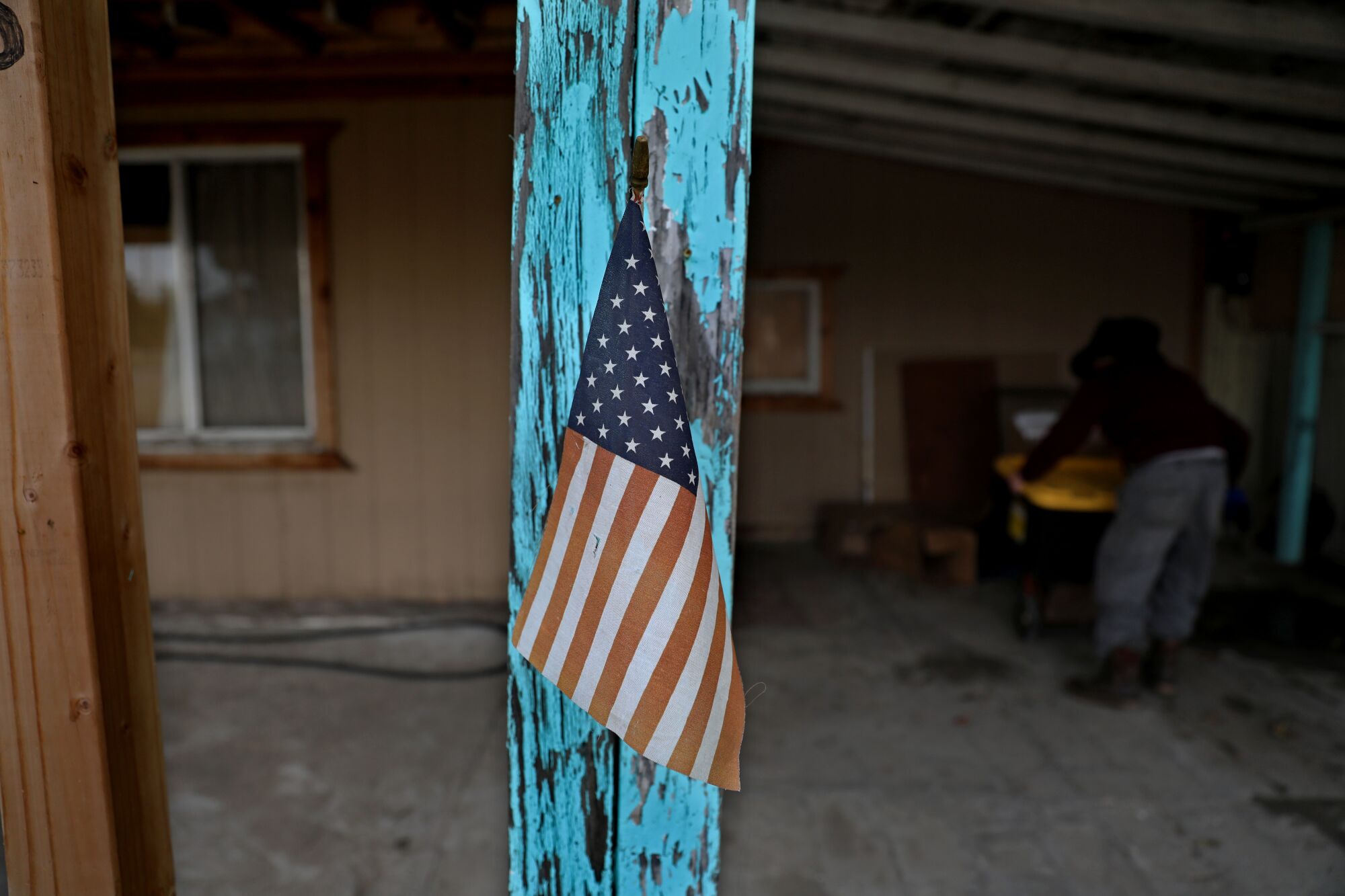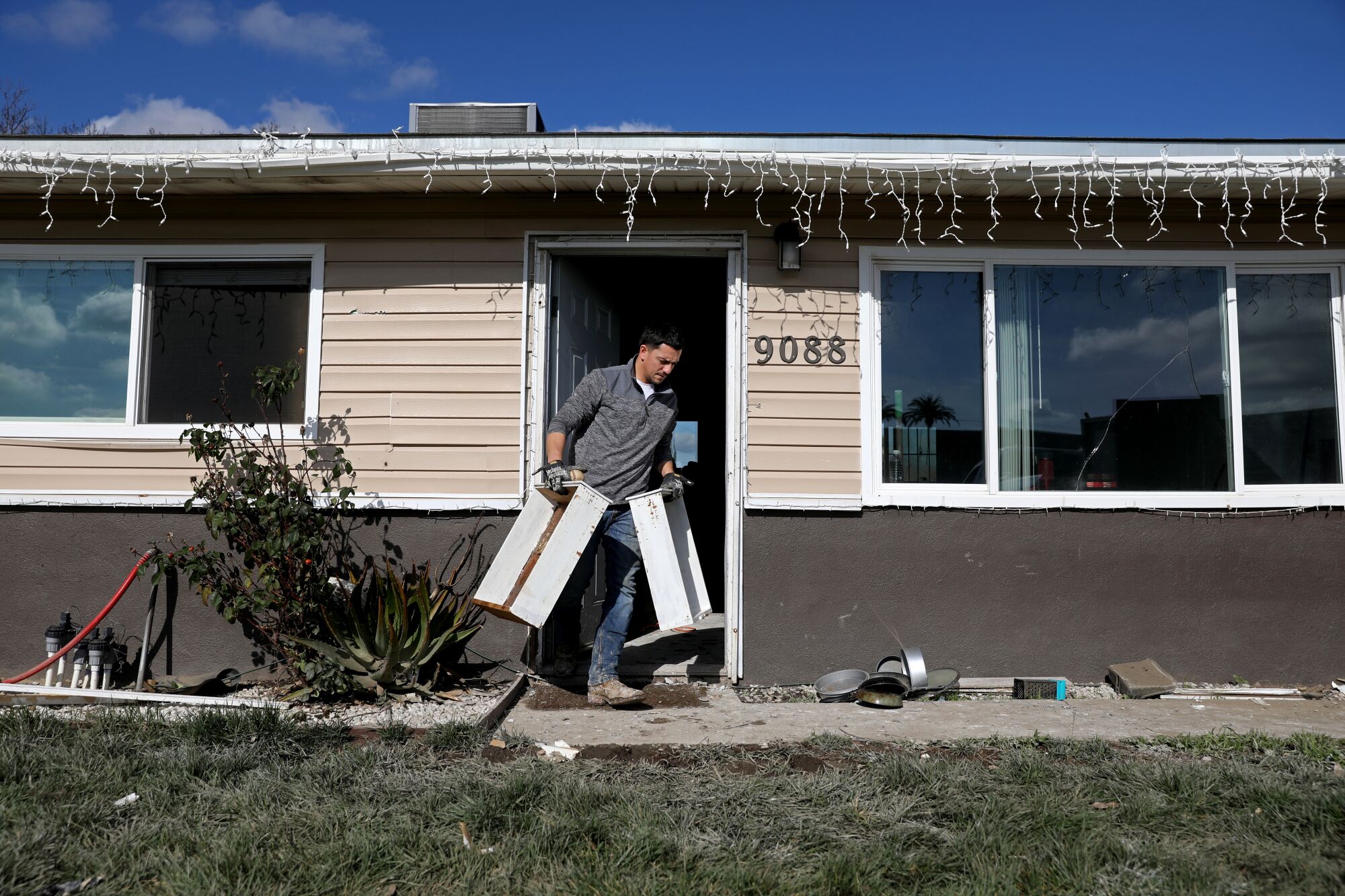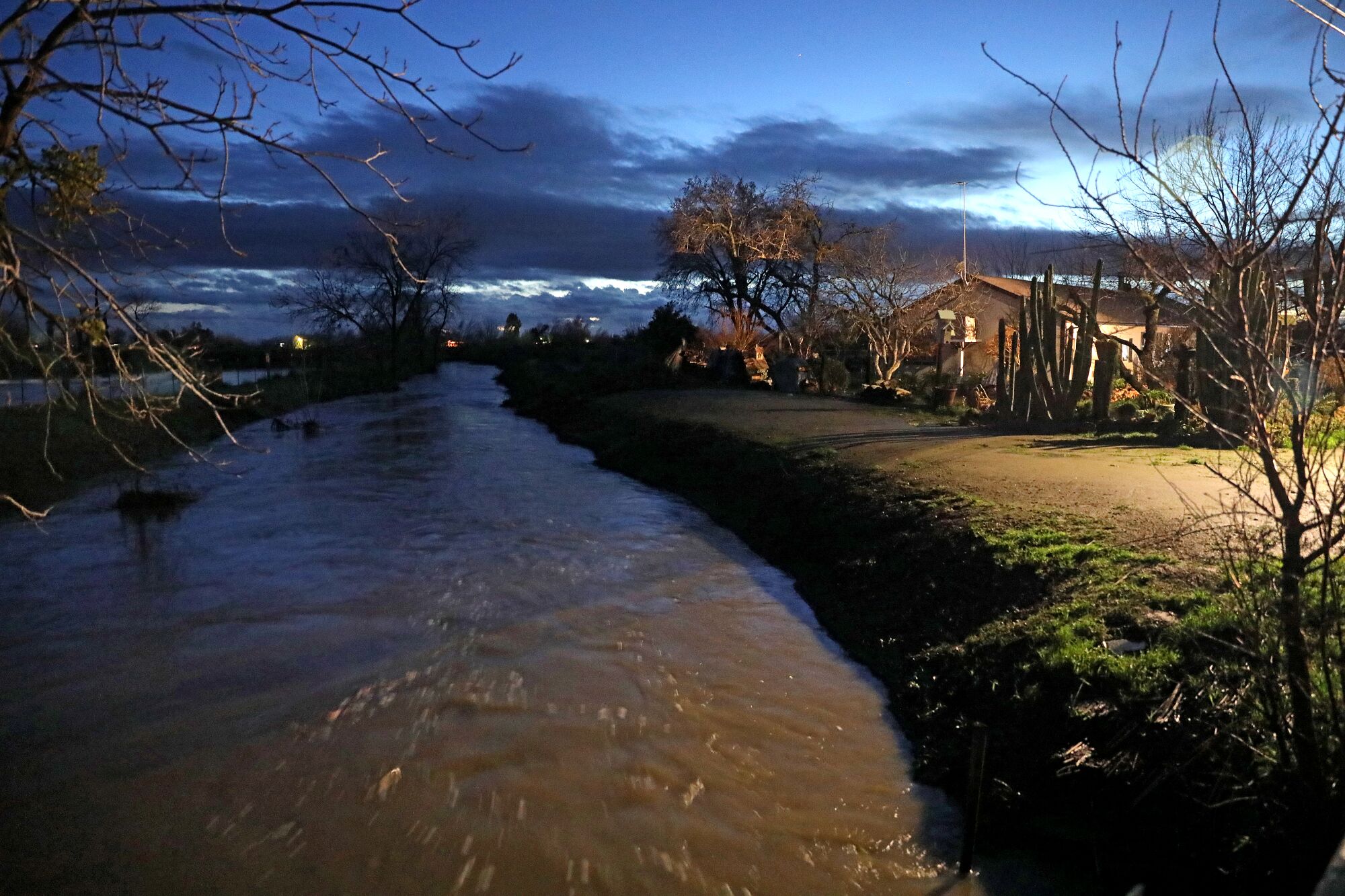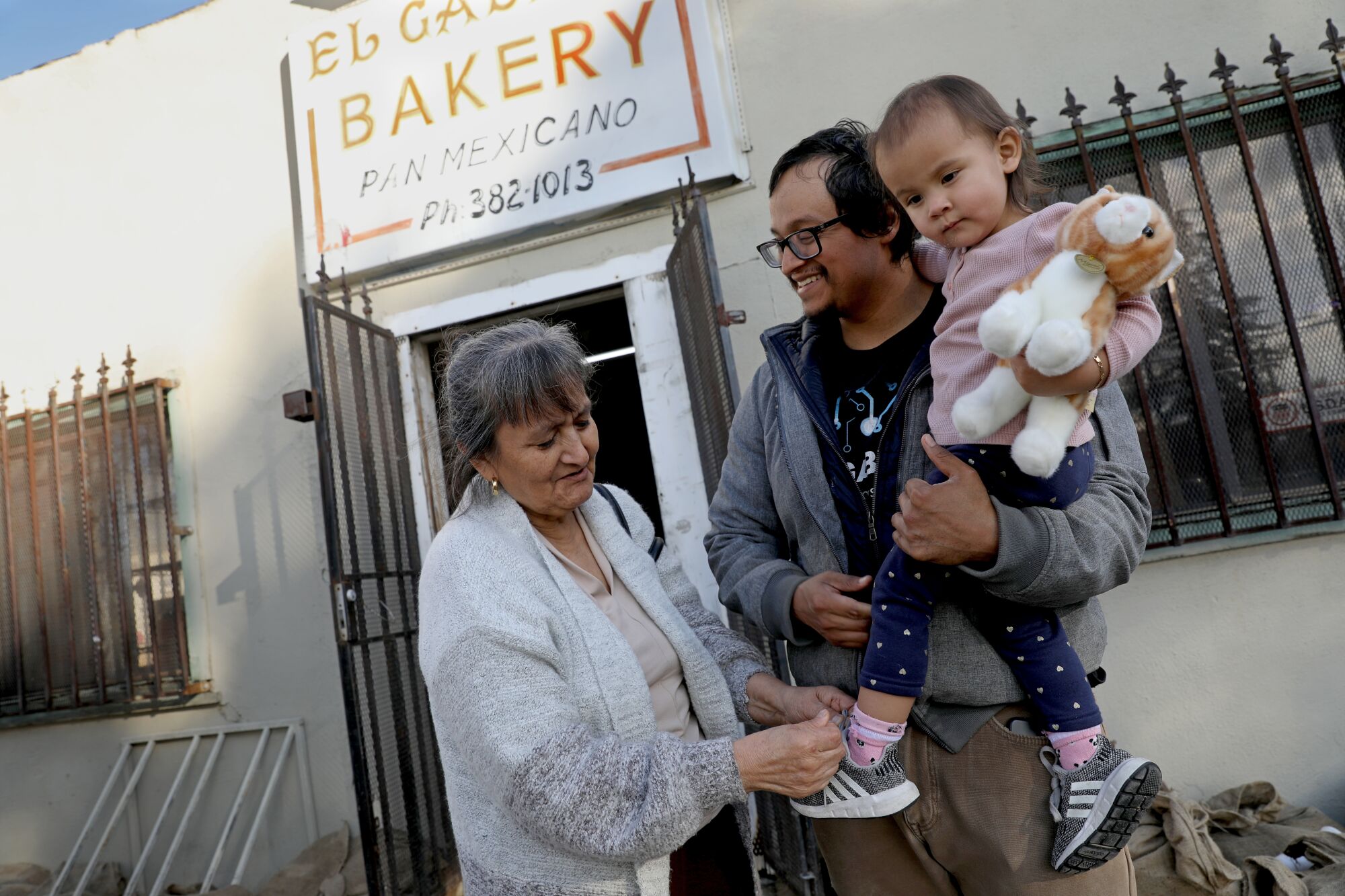Can Planada recover from January storms? ‘You have a community that is angry’

Once the levee broke, the water rose so quickly that in the few minutes it took Erica Lopez Bedolla to decide to evacuate and gather her children and a few necessities, it had surged from her ankles to her knees.
What followed that night in early January was the stuff of nightmares: a fearful scramble through pelting rain; a flooded car engine that stopped cold; a frantic escape on foot through dark, brackish water. Then, days later, more misfortune: Not only was her house flooded, but so was her mother-in-law’s, and her mother’s, and her brother’s.
Not to mention that Bedolla’s home was one of about 40 in the town of Planada whose valuables were stolen in the aftermath of the evacuation.
So it took a few days for Bedolla to focus on the issue now consuming many in this tightknit, impoverished community of 4,000 tucked at the base of the foothills below Yosemite National Park: What will happen to Planada?

More than a month after the flood, Erica Bedolla Lopez and her family were still trying to figure out what to do. She and her husband applied for federal assistance.
(Gary Coronado / Los Angeles Times)
Most of the town was inundated. About half the homes were damaged and so was the elementary school. Many homes were destroyed. Most residents do not have savings to fall back upon, let alone flood insurance. Many residents are farmworkers in the U.S. illegally, making it more difficult to qualify for federal disaster funds.
The challenges are daunting: How will people rebuild? Will a significant slice of the population wind up permanently displaced? How should the county, state and federal governments help?
Bedolla and her family spent a few days at her sister-in-law’s in Merced, then relocated to temporary shelter at Felix Torres Housing, a housing project for migrant farmworker families run by Merced County. But they — and the dozens of other Planada families offered units there — could stay several weeks. No one thought it would be enough time to repair all the damaged homes, if they could be repaired at all.
Bedolla stood in the living room of the utilitarian unit a week after the flood, looking at the sparse furniture and the displaced children playing soccer outside beneath the setting sun.
“What are we going to do now?” she asked, talking about her family and her town.

Adam Gonzales stands where last month’s storms caused the Planada Canal and Miles Creek to overflow and flood the town of Planada.
(Gary Coronado / Los Angeles Times)
Earlier this month, at a community meeting at Planada’s Cesar E. Chavez Middle School, residents took turns asking a version of this question over three angry hours, also blasting government officials for the failure to issue timely evacuation orders and the slow pace of relief efforts.
They pointed out that Planada is currently without mail service and healthcare services. Its charming streets are filled with moldy detritus.
Some accused the Merced Irrigation District of negligence in failing to maintain the levee and keep brush out of Miles Creek, which burst its clogged banks on the night of Jan. 9. Some even suggested officials may have flooded the town intentionally, calculating that if they sent the water toward Planada it would spare other places.
About an hour into the meeting, Anjian Aguilar, 13, stepped up to the microphone.
“Will this city finally get the care it needs?” she demanded. The town, she said, has “no storm drains, no streetlights. We are literally a town of Hispanics left in the dark. Look around. You have a community that is angry.”
She said her family had fled their rented home as water began to rise. They are now staying at Felix Torres while her parents rebuild the rental. Their landlord doesn’t want to do it.
“We are traumatized and scared,” another woman added. “What is the county going to do to take care of its rural communities?”
At a long table in front of residents, government officials — from the county, the Federal Emergency Management Agency and the Governor’s Office of Emergency Services, among others — listened and tried to offer solutions to individual bureaucratic problems.
But to the larger questions facing the town’s future, they acknowledged the answers were more difficult.
County Supervisor Rodrigo Espinosa said there was a housing shortage “before the floods, and now it’s worse.” He added that he is frustrated that county and state officials are not responding with enough urgency to either the housing crisis or the infrastructure problems.
“It’s been awful,” he told the crowd.

The town of Planada is trying to get back on its feet after a series of storms last month. But county and state officials are not responding with enough urgency to housing and infrastructure problems, a Merced County supervisor said.
(Gary Coronado / Los Angeles Times)
Planada was born as a real-estate development fantasy that didn’t quite come to fruition.
J. Harvey McCarthy, a Southern California developer, bought the town, which was then a tiny development of Swiss settlers known as Geneva. It was renamed Planada around 1912, and a marketing campaign insisted it would soon become “the Palm Springs of Central California.”
McCarthy hired landscape architect Wilbur David Cook, who also worked on Exposition Park in Los Angeles and Balboa Park in San Diego. In short order, Planada had a school, theater, hotel and library.
What it did not have were lots of people with money willing to purchase new homes, at least not before McCarthy became embroiled in a business dispute with his investors and the whole plan foundered.
Planada, which is about nine miles east of Merced on Highway 140 en route to Yosemite, instead developed into a rural community centered on a plaza and a town park that are surprisingly grand and elegant for a dusty San Joaquin Valley farm town.
Many of the residents are farmworkers, who arrived to toil in the fields and stayed for generations. They held fast despite the town’s lack of resources because of its charming feel and tightknit community.

Mike Hurtado removes flood-damaged cabinets at his home along Stanford Avenue in Planada, Calif. January storms caused major damage when floodwater reached 4 feet inside his house.
(Gary Coronado / Los Angeles Times)
But for all its grand ambitions and stylistic architectural touches, the community never got the other accouterments of even basic planning — sufficient storm drains, streetlights, even many sidewalks. Nor did Planada, which is unincorporated, ever get its own governance. Instead it is dependent for services on a county that many residents, including the current county supervisor, say has often neglected it.
Over the years, the local newspaper, the Merced Sun Star, has taken notice of violence, poverty, a lack of housing and sewage problems in the town. Planada has also suffered flooding before, most notably in 2017, when the elementary school flooded and was rebuilt.
But no one was prepared for what happened that terrible Monday five weeks ago.

Miles Creek, which runs southeast of Planada, Calif., burst its banks during last month’s storms and busted through the levees designed to contain it.
(Gary Coronado / Los Angeles Times)
Miles Creek, which runs southeast of the town, burst its banks and busted through the levees designed to contain it. Many residents said they didn’t get any order to evacuate until the sheriff came door to door, and by then it was almost too late.
People watched in shock and horror as water flooded into their homes, and when they tried to flee in their cars, they were swamped and had to be rescued.
It was a miracle, people in town said over and over, that no one died.
The next morning, Alex Martinez, who grew up in Planada but now lives in Merced, rushed over in his truck to help with the evacuation. He flew a drone camera over block after block of homes that appeared to be floating in a lake of brown water.

Estella Villagomez, left, her son, Leonardo Villagomez, and granddaughter Olivia Cisneros, 2, stand outside their flood-damaged family-run business El Gallito Bakery in Planada, Calif., in January.
(Gary Coronado / Los Angeles Times)
Estella Villagomez, 69, fainted when she beheld the damage to the bakery she and her husband run. One of her sons caught her before she crashed to the tile floor.
El Gallito Bakery sits near the center of town, offering pan dulce and doughnuts, along with menudo on Sundays. Villagomez’s husband, Luis, worked as a baker as a child in his village in the Mexican state of Guanajuato, and eventually got a job as a baker in Planada. Two decades ago, he and his wife finally scraped enough money together to buy the place.
Villagomez runs the register and freely hands out pastries on credit, maintaining an idiosyncratic accounting of who owes what. If she doesn’t know a customer’s name, she pens descriptions in her ledger, such as “man with a scruffy beard,” which her children find both charming and hard to parse.

Hailey Cisneros, a student at UC Davis, helps her grandparents paint the walls of their damaged El Gallito Bakery in Planada, Calif.
(Gary Coronado / Los Angeles Times)
El Gallito, in short, was the fulfillment of a lifelong dream for the couple. A few years ago, they had even gotten a contract with UC Merced for pan dulce and doughnuts that had, at long last, helped financially stabilize the operation.
After the flood, it seemed, it all was destroyed. Brown water stains climbed up the walls. The Villagomez home was just as bad. Almost all the furniture would have to be thrown out before the family moved back in and the walls rebuilt.
But the Villagomez family and much of Planada had the same response to the disaster. They called in their relatives and everyone got to work. The county had dropped off dumpsters. Residents filled them with detritus.
And they started trying to rebuild the town themselves.
One afternoon a week after the storm, three generations crowded into El Gallito and its connected kitchen.
“I just need the other paintbrush,” a granddaughter called. An uncle went to get it for her. Villagomez’s youngest grandchildren wandered around, hoping someone would take them to the nearby park, which their father finally did.
The family’s labors were interrupted again and again with customers dropping by, a hopeful look in their eyes, asking if somehow the bakery had managed to reopen.
On Jan. 25, two weeks and two days after the flood, it did.
“We’ve been selling out,” said Miguel Cisneros, Villagomez’s son-in-law.
He said that, as horrible as the flooding was, for El Gallito, it also brought blessings. After family and friends posted about the bakery’s plight on social media, donations rushed in. One customer who runs a construction business sent his employees to help replace plastic wallboard. Others sent money.
“There is a good support system in this little town,” Cisneros said. “It was horrible for a time, but I think we will come out better.”
If only everyone in town could say the same, he added, but he knew that wasn’t the case.
More than a month after the flood, Bedolla and her family were still trying to figure out what to do.
She and her husband applied for relief from FEMA and are waiting to hear what they might get. Once her children’s school reopened, she spent her days on the grim mathematics of disaster recovery.
Bedolla and her husband are selling their truck and plan to use the money to rebuild their home. Her sister-in-law set up a GoFundMe campaign to try to raise money, but it was far from a panacea.
Many in her community say they will be forced to move away. But Bedolla can’t imagine leaving her beloved town.
“It was so quick,” she said of the speed with which the water came in and flooded it all. And after a flurry of attention from the outside world, she said, it felt as if everyone had “forgotten this happened.”
Share this news on your Fb,Twitter and Whatsapp
Times News Network:Latest News Headlines
Times News Network||Health||New York||USA News||Technology||World News